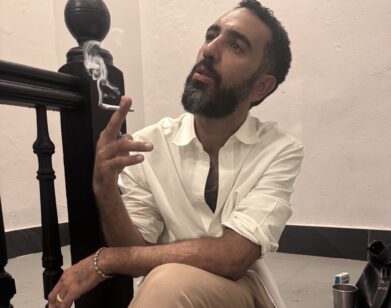Max Hooper Schneider’s Sculptures May or May Not Include a Dead Mouse

Shirt by CALVIN KLEIN JEANS. Vest, Pants, and Earring MAX’S OWN.
One of Max Hooper Schneider’s biggest creative influences is his mother. A retired professor of urban studies, Barbara Hooper once wrote an elegantly esoteric press release for her son’s art show, and it’s through her study of the 17th-century philosopher Spinoza that Schneider hit upon one of the most important tenets of his work: the interrelatedness of all matter. Schneider also happens to consider Barbara his best friend. Last April, he made the trip from his hometown of Los Angeles to his mom’s place outside of Santa Fe. En route, he drove a truckload of the materials he obsessively collects for his art production: junk jewelry, his late father’s veterinary equipment, pounds of plastic succulents, and discarded neon signs. Schneider had only a vague sense of what his new work might entail, but his stay in the desert proved fruitful. Back in L.A., dozens of new sculptures now fill his hangar-size studio in the sun-worn, industrial section of Gardena. “When I’m happy, I’m really prolific,” says the 37-year-old artist. “These are the worlds I want to be in. This is my social life.”
Somewhere along the way back from New Mexico, a mouse crawled into a large sculpture—constructed out of a burnt locker, the distressed arm of a Raggedy Ann doll, petrified gummy worms, and more junk jewelry—and died. Schneider is hoping the smell fades by the time he installs this new work in L.A.’s Hammer Museum for his very first solo museum show, which opens this September. The addition of the dead mouse may have been accidental, but fusing the organic and the man-made is one of the artist’s primary obsessions. (Schneider is probably best known for his eerie, witty terrarium sculptures that look like the stuff of bioengineering nightmares. It’s no surprise that his job in high school consisted of servicing home aquariums. In the past, he has exhibited vitrines filled with algae-like lingerie and starfish submerged in murky water. He cast a beluga whale skeleton covered in glow-in-the dark resin and retrofitted a treadmill with a conveyor belt fashioned out of fake crocodile skin.)
The Hammer show will take the form of a life-size bioactive lagoon, a kind of floating trash island not unlike those he came across during his travels to reefs around the world. Schneider is currently weighing the possibility of including a moat teeming with crabs, being, as he is, such a big fan of invertebrates because they can survive under the harshest of conditions. “These are the things that will inherit the earth,” he promises. And yet, his vision isn’t exactly dystopian. “This isn’t a speculation,” he says. “This is reality. Crabs on trash. It’s as simple as that.”
———



———
Hair: Whitney Schield at Atelier Management
Makeup: Ozzy Salvatierra at Lowe & Co
Set Design/Prop Stylist: Jon Anthony
Fashion Assistant: Dustin Ellis






